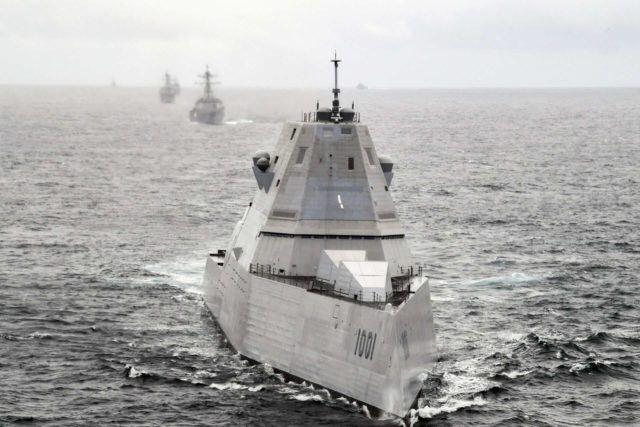
Navy to arm three warships with hypersonic missile launchers The Zumwalt-class guided-missile destroyer USS Michael Monsoor. (Chief Petty Officer Shannon Renfroe/U.S. Navy/TNS)
The U.S. Navy is planning to arm San Diego-based warships with new hypersonic missile launchers, replacing the current guns on three ships, new reports revealed since last week.
According to the United States Naval Institute (USNI) last week, the Navy is preparing to remove two 155mm guns from three destroyers and put missile launchers in their place.
The changes will take place on the USS Zumwalt and USS Michael Monsoor, which are already in San Diego, and the USS Lyndon B. Johnson, which will be stationed there, as well.
The USS Zumwalt will be finished first, likely by 2025.
Once the project is completed, the ships will be able to launch Common-Hypersonic Glide Bodies, which are currently being developed by the Army, Air Force and Navy.
In addition to retrofitting old warships with hypersonic weapons systems, the Navy revealed in January a future warship concept capable of firing hypersonic missiles and lasers that are ten times more powerful than existing weapons.
According to a breakdown of the next-generation warship, the DDG(X) is designed to “provide flexibility for increased missile capacity, sensor growth, longer range offensive anti-surface and strike capabilities, high power Directed Energy weapons (lasers), increased survivability, and increased efficiency to reduce operational costs and demands.”
The Navy told USNI News that it will begin construction on the new warship in 2028.
“Capabilities that we’re going to need for the 21st century to continue combating the threat are increased missile capability sensor growth, directed energy weapons, which actually require a lot of power, increased survivability and increased power availability,” deputy program manager Katherine Connelly said in January.
Late last year, U.S. Space Force Gen. David Thompson said the U.S. has “a lot of catching up to do” in terms of hypersonic weapon technology and it must do it “very quickly” in order to keep up with China and Russia.
In an interview for the Halifax International Security Forum, Thompson said the U.S. and its allies are “still the best in the world” in terms of space technology, but that China’s technology, in particular, has advanced at a greater pace than the U.S. and, in terms of hypersonic weapons, the U.S. has actually fallen behind.
“We’re not as advanced as the Chinese or the Russians in terms of hypersonic programs,” he admitted. “The Chinese have had an incredibly aggressive hypersonic program for several years.”
Thompson noted that hypersonic missiles lack the “predictability” of typical ballistic missile attacks, which allows for “the ability to warn” of an incoming missile.
“What a hypersonic missile does is it changes that game entirely,” Thompson continued.




